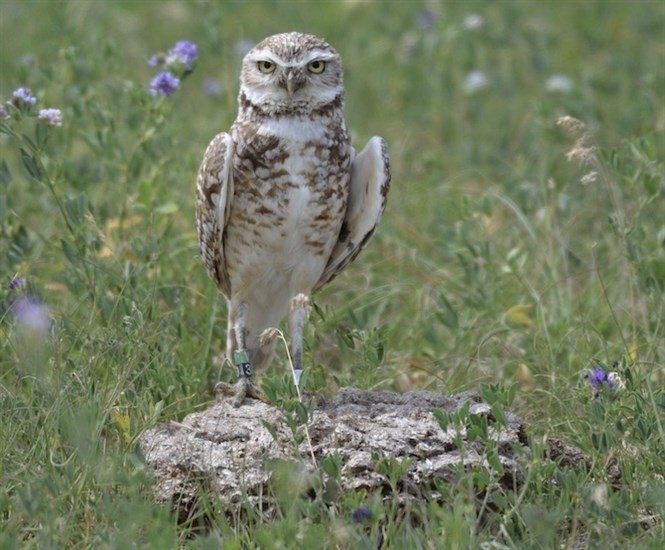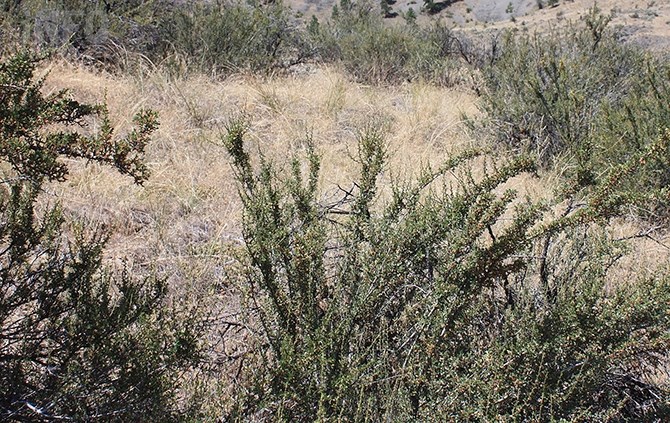
A UBCO new study is using the burrowing owl as an example of just one specie that relies on grassland habitats.
November 27, 2023 - 7:30 AM
A new UBCO study is showcasing the Okanagan’s forgotten and endangered grasslands by drawing attention to the burrowing owl.
According to the Government of British Columbia, grasslands account for 27% of the South Okanagan and Lower Similkameen landscape. However, they have been heavily impacted by livestock grazing, agriculture, and urban development.
A new study, spearheaded by Dr. Lilian P. Sales Macedo, aims to draw attention to these important and neglected ecosystems by using one of its most well-known residents, the burrowing owl.
Macedo told iNFOnews.ca she wanted to use this “cultural icon that links the land, people and conservation efforts to try and raise awareness to the preservation of the grassland ecosystems.”
“We chose the burrowing owl because, despite its low abundance, (it) is often used as a symbol for grassland preservation,” Macedo said. “Whenever you ask people to name a species of the grasslands, they will often name the burrowing owl.”
Burrowing owls rely on grasslands to find their nests. That’s right, find. Not make.
These owls will find burrows left by animals like the American badger, another endangered grassland species, to make their own nesting sites.
“It has this fascinating relationship with grassland ecosystems, but also to other species as well," Macedo said. "So, our hope was to use the burrowing owl as an umbrella species to raise awareness to the preservation of the grasslands. If you preserve the burrowing owl habitat, you end up preserving the same habitat for other species as well.”
The burrowing owl can be found from South America all the way up to Canada. However, with climate change, it is expected the bird will need to find more habitats up north as things heat up.
“That's why we need to preserve native grasslands because, not only the Burrowing Owl, but other species as well might need those intact habitats to support their population expansions towards Canada,” Macedo said.
Countless species of plants and animals rely on grasslands to survive. Unfortunately, humans also have a tendency to gravitate towards these open and practical landscapes.
“Across the globe, (grasslands) are a threatened ecosystem because they are easy to be adapted to human land uses,” Macedo said. “You can just, for example, release cattle and you will immediately be able to convert that land into a different kind of use.”
In the Okanagan, grasslands tend to occur in lowland regions and flat terrain, which provides an ideal plot for urban expansion, Macedo explained.
Grasslands also lack conservation appeal. Where the ecological value of forest may seem obvious, it takes a skilled eye to see the rich biodiversity hidden in grasslands.
“When I first started working with grasslands, I realized that it's all about the detail. When you look at a forest, you can see it from the distance. You can see the tall trees from the distance, but to really appreciate the grasslands, you need to get closer. You need to get this kind of on the ground relationship with the land. And I think that is beautiful because it also brings a kind of spiritual meaning to your relationship to the land as well.”

The South Okanagan is home to desert habitat such as Antelope brush sub-steppe grasslands.
(STEVE ARSTAD / iNFOnews.ca)
And grasslands are quantifiably comparable to forests, Macedo said, especially for their ability to store and sequester carbon dioxide underground, just like trees.
“What is below ground is usually hidden… So it kind of escapes our conservation attention and policy,” Macedo said. “Grasslands are a type of ecosystem that has been suffering from conservation neglect, not only at the local scale, but at the global scale as well.”
Grasslands are also far more resistant to wildfires, something that will make them more appealing in years to come.
“We expect that the future will bring harsher and stronger fire regimes, not only in the Okanagan, but in several parts of the world," Macedo said. "So we need to acknowledge that and to give the proper value to grassland ecosystems.”
In order to preserve these important yet neglected landscapes, protected areas will need to be created Macedo said. Education will also be vitally important.
“Overall, we need to first raise awareness of its importance. We need to understand that there is value there,” Macedo said.
More information on Dr. Macedo's study can be found here.
To contact a reporter for this story, email Georgina Whitehouse or call 250-864-7494 or email the editor. You can also submit photos, videos or news tips to the newsroom and be entered to win a monthly prize draw.
We welcome your comments and opinions on our stories but play nice. We won't censor or delete comments unless they contain off-topic statements or links, unnecessary vulgarity, false facts, spam or obviously fake profiles. If you have any concerns about what you see in comments, email the editor in the link above. SUBSCRIBE to our awesome newsletter here.
News from © iNFOnews, 2023